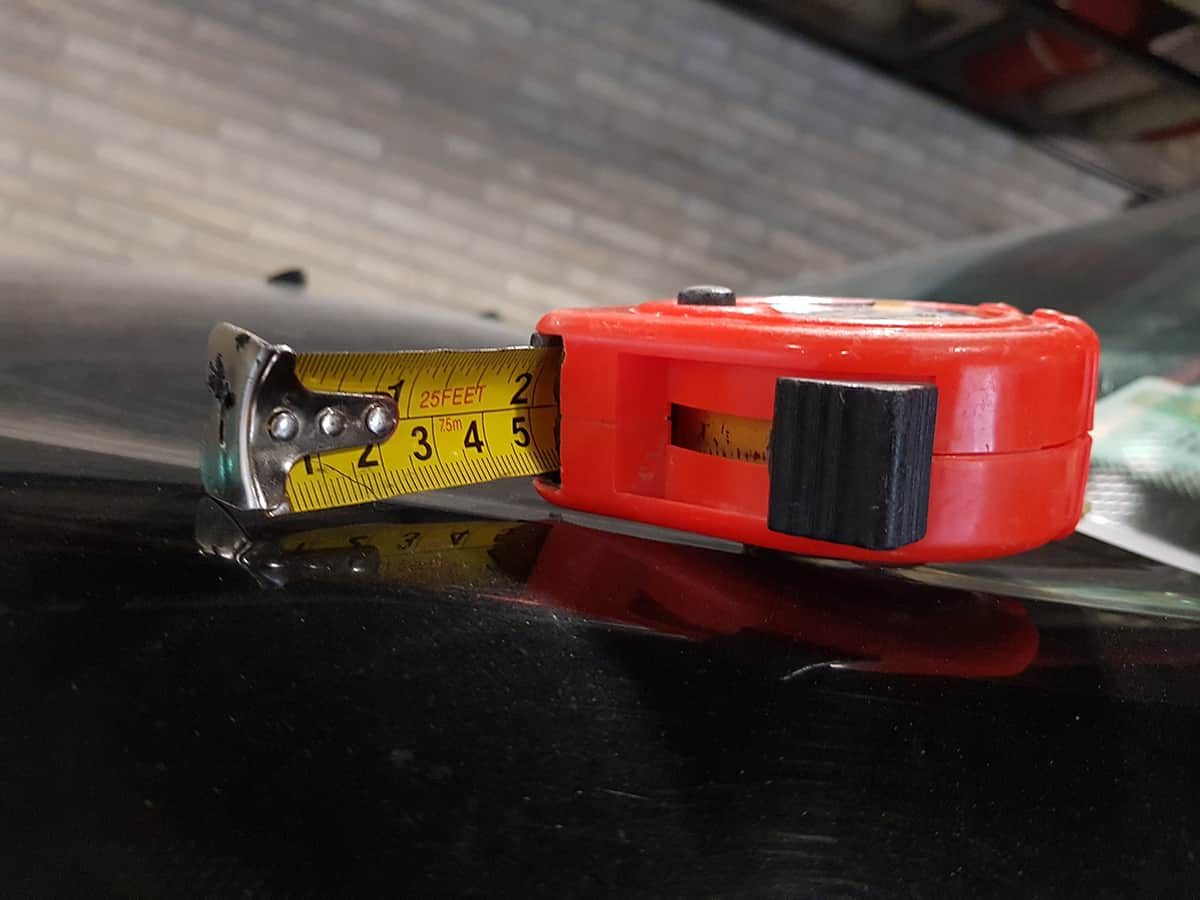In the realm of automobiles, car length is more than just a figure on a spec sheet. This seemingly simple measurement plays a pivotal role in determining a car’s aesthetics, handling, fuel efficiency, parking ease, and interior spaciousness. It’s an element of car design that can directly influence your driving and ownership experience.
The average length of a car, typically measured bumper to bumper, is approximately 4.5 meters or 14.7 feet.
This guide goes into the intricacies of car length. We’ll examine the importance behind it, relate it to other vehicle dimensions, and offer a quick lesson on how to measure your car’s length.
The Practical Implications of Car Length

While car length might seem like a straightforward dimension, its real-world implications extend far beyond how long a vehicle measures from bumper to bumper. The length of your car can influence everything from parking ease to interior comfort, presenting a diverse range of practical considerations.
1. Parking Challenges
Longer cars, such as luxury sedans or SUVs, require larger parking spaces and can be more challenging to maneuver in tight spots or multi-story parking garages.
In contrast, smaller vehicles, like compact cars or hatchbacks, can fit into smaller spaces and are typically easier to park, particularly in crowded city streets or parking lots. These compact dimensions can also aid in navigating through narrow lanes or heavy traffic.
2. Interior Space and Comfort
A longer vehicle generally translates into a more spacious cabin and a larger trunk, providing increased legroom and luggage capacity. This can significantly enhance passenger comfort, especially on longer journeys or road trips.
However, a longer car does not always mean more interior space. The layout and design of the interior, along with the wheelbase, also play a critical role. For instance, some compact cars have a long wheelbase relative to their overall length, optimizing cabin space.
3. Navigating City Life
For city dwellers, the length of their car can have daily implications. In densely populated urban areas with heavy traffic and limited parking, owning a compact car can make life significantly easier.
Smaller cars are not only easier to park but are also typically more fuel-efficient, particularly in start-stop city traffic. They’re also more agile, making it easier to navigate through congested streets.
4. Garage Dimensions
When buying a car, it’s important to ensure it fits into your garage or parking space comfortably. While this might seem obvious, it’s an often overlooked aspect.
Average garage sizes vary, but in many cases, they might struggle to accommodate larger vehicles, such as pickup trucks or extended-length SUVs. It’s therefore crucial to consider your available parking space when choosing your car’s size.
Car Length in Relation to Other Vehicle Dimensions
Understanding car length isn’t just about knowing how long a vehicle is from its front to rear bumper. This dimension has a relationship with other key metrics such as width, height, and wheelbase, which are equally critical in shaping the car’s aesthetics, performance, and functionality.
How Car Length Connects with Width and Height
Car length, width, and height are three essential dimensions that dictate a vehicle’s overall size and space.
- The length is often the most noticeable, largely influencing a car’s design, road presence, and parking ease.
- Width plays a pivotal role in determining interior space, particularly the elbow room and seating capacity.
- Height is integral for headroom and contributes to the vehicle’s overall stability, with lower cars typically being more stable.
A harmonious balance between these three dimensions is crucial in car design. For example, a long but narrow car might look awkward and offer less lateral interior space, despite having a large boot.
Conversely, a short but wide car could appear disproportionate and struggle with aerodynamics, though it might provide ample elbow room. A car with a high height-to-length ratio, such as an SUV, provides an elevated seating position and improved visibility, but might be prone to body roll.
Car Length vs. Wheelbase
The wheelbase of a car, the distance between the center of the front and rear wheels, is another significant factor. Though it’s less than the total car length due to the overhangs at both ends, the wheelbase has a direct impact on the vehicle’s handling and interior space.
A longer wheelbase usually results in better stability and a smoother ride, as it can better distribute the car’s weight and absorb shocks. Moreover, it often translates to more interior space, especially legroom, as the distance between the front and rear axles corresponds to the maximum cabin length.
A Global Perspective on Average Car Length
The average car length is not a fixed figure; it varies significantly across different regions due to factors like local infrastructure, driving conditions, cultural preferences, and even climate. By taking a global perspective, we can gain insights into the diversity of car dimensions and the factors that influence them.
North American Trends in Car Lengths
In North America, larger vehicles such as SUVs, pickup trucks, and minivans have gained substantial popularity. These vehicles typically exceed the global average car length due to their enhanced capacity and comfort features. For example, pickup trucks, a quintessential element of American automotive culture, can stretch well over 5 meters in length.
The abundance of space, both on roads and in residential areas, combined with lower fuel prices compared to many other countries, makes owning and operating these larger vehicles feasible.
European Preferences
Europe, with its narrow city streets, dense population, and high fuel prices, has a preference for smaller, more efficient cars. Hatchbacks and compact cars, often less than 4 meters long, are common due to their maneuverability and fuel efficiency.
That’s not to say larger vehicles are absent; luxury sedans and SUVs are also prevalent, particularly in countries like Germany and the UK. However, these vehicles are typically more compact than their American counterparts.
Asia and the Rise of Compact Cars
Asian markets, similar to Europe, tend towards smaller vehicles due to the densely populated urban environments and the premium placed on fuel efficiency. Japan, in particular, has a unique category of vehicles called “Kei cars,” limited to a maximum length of 3.4 meters. These vehicles, designed to navigate narrow streets and tiny parking spaces, exemplify the influence of infrastructure on car length.
However, the growth of the middle class in countries like China and India has boosted the demand for larger vehicles, such as SUVs and luxury sedans, in recent years.
How to Measure Your Car’s Length

Here’s a detailed guide to help you measure your car’s length accurately, including some tips and precautions to consider.
What You’ll Need to Measure Your Car’s Length
To measure your car’s length, you will need a clean, flat surface, a tape measure that is longer than your vehicle, and possibly an assistant to help ensure accuracy. This task is best done in a well-lit space to allow for clear visibility of the measurements.
The Measurement Process
- Prepare the Car: Ensure the car is on a level surface and parked straight. The car should be fully closed, with all doors, windows, and the trunk shut.
- Take Initial Position: Position the tape measure at the very front of the car. This is usually the front bumper or any part of the car that protrudes further.
- Extend the Tape to the Rear: Extend the tape all the way to the rear-most part of the car. Again, this could be the rear bumper or any other component that extends beyond it. Make sure the tape is taut and straight for an accurate measurement.
- Record the Measurement: Check the measurement and record it. It might be helpful to measure a couple of times to confirm the accuracy.
Measuring Other Dimensions
While you’re at it, you might want to measure other dimensions of your car, such as the width and height. The process is similar, but always ensure to include mirrors in your width measurement and to measure height from the tallest point of the car.
Knowing your car’s exact dimensions can help you understand its compatibility with your garage space, the ease of parking, and even what kind of car cover you might need.
FAQs
1. What is the average length of an SUV versus a sedan?
Sedans and SUVs represent two distinct vehicle classes, each with its own typical length. A sedan’s average length usually ranges between 14.7 to 16.9 feet. Compact sedans tend to be on the shorter end of this range, while full-size sedans lean towards the longer end.
On the other hand, SUVs vary even more in size due to the different subcategories: compact, midsize, and full-size. Compact SUVs average between 14 to 15 feet in length. Midsize SUVs tend to be between 16 to 18 feet long, while full-size SUVs can extend well beyond 18 feet, sometimes reaching up to 20 feet.
2. What is the longest car currently in production?
In the 1970s, car manufacturers, especially Chrysler, competed to build the largest vehicles. This trend culminated in the 1973 Imperial LeBaron, the longest sedan ever made at 235.3 inches (5.97 meters). Chrysler used bumper regulations introduced in 1973 to extend the chrome and thus the car’s length.







